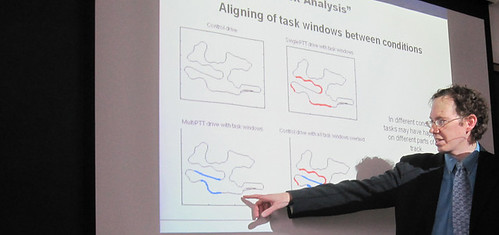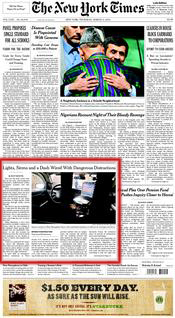 Last week I was interviewed by Randall Stross for an article that appeared in the September 2 edition of the New York Times. Mr. Stross’ article, “When GPS Confuses, You May Be to Blame,” discusses research on in-vehicle personal navigation devices, including our work on comparing voice-only instructions to map+voice instructions [1].
Last week I was interviewed by Randall Stross for an article that appeared in the September 2 edition of the New York Times. Mr. Stross’ article, “When GPS Confuses, You May Be to Blame,” discusses research on in-vehicle personal navigation devices, including our work on comparing voice-only instructions to map+voice instructions [1].
Specifically, Mr. Stross reports on a driving simulator study published at AutomotiveUI 2009, in which we found that drivers spent significantly more time looking at the road ahead when navigation instructions were provided using a voice-only interface than in the case when both voice instructions and a map were available. In fact, with voice-only instructions drivers spent about 4 seconds more every minute looking at the road ahead. Furthermore, we found evidence that this difference in the time spent looking at the road ahead also had an effect on driving performance measures. These results led us to conclude that voice-only instructions might be safer to use than voice+map instructions. However, the majority of our participants preferred having a map in addition to the voice instructions.
This latter finding was the impetus for a follow-on study in which we explored projecting navigation instructions onto the real world scene (using augmented reality) [2]. We found that augmented reality navigation aids allow for excellent visual attention to the road ahead and excellent driving performance.
References
[1] Andrew L. Kun, Tim Paek, Zeljko Medenica, Nemanja Memarovic, Oskar Palinko, “Glancing at Personal Navigation Devices Can Affect Driving: Experimental Results and Design Implications,” Automotive UI 2009
[2] Zeljko Medenica, Andrew L. Kun, Tim Paek, Oskar Palinko, “Augmented Reality vs. Street Views: A Driving Simulator Study Comparing Two Emerging Navigation Aids,” MobileHCI 2011





 I also had a chance to give a talk reviewing some of the results of my collaboration with
I also had a chance to give a talk reviewing some of the results of my collaboration with 
